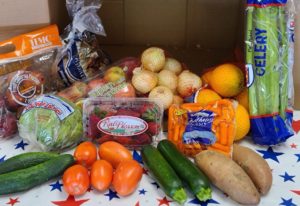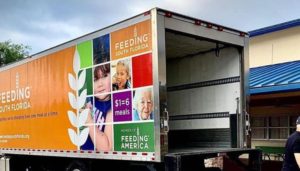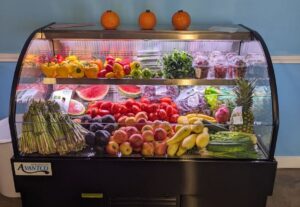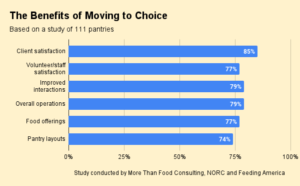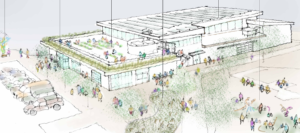When demand for charitable food ratcheted up in the early stages of the pandemic, San Diego Food Bank responded like many of its peers — with mass distributions aimed at getting food to hundreds or even thousands of people at a time. But the results of those efforts did not always sit well with James Floros, the food bank’s President and CEO.
While the food bank was prepared to serve about 1,000 cars during each of the four mass distributions it held, up to 3,000 to 4,000 cars would actually show up. After waiting for hours, up to two-thirds of the people in line might leave without food. “That’s not good,” Floros said. “That breaks your heart.”
In its search for a better way, the food bank took note of the smooth-running distributions happening at its North County Food Bank warehouse. The walk-in pantry there typically served about 10 families a day, but saw demand spike to 200 to 300 cars a day when the pandemic hit. In response, the staff set up a drive-through distribution, available every day and for extended hours, which easily handled the extra volume. During a single week, the site was serving up to 1,500 households, more than the typical volume at a mass distribution. “It was totally mellow, with no need for law enforcement,” Floros noted.

Liking what it saw, San Diego Food Bank took the concept of a high-capacity pantry and ran with it, moving away from mass distributions in favor of creating a network of “super pantries” that operate across its service area and are designed to handle high volumes. “We’re going back to our roots, with local pantries that offer client dignity,” Floros said.
While other food banks have seen their distribution networks ebb and flow over the course of the pandemic, with some smaller pantries closing and others naturally taking on higher volumes, San Diego Food Bank has been very deliberate in its super-pantry selection process. In early June, it invited its 500 distribution partners to apply to become super pantries through a request-for-proposal process. Out of a pool of more than 100 that applied, the food bank selected 35 super-pantry partners, strategically located throughout its operating area.
The new super pantries will start serving families on July 1 and be required to hold distributions at least three times a week through the end of the year. Each has received a one-time $20,000 capacity-building grant made possible by donors to the food bank’s Covid-19 Response Fund, which will support purchases such as refrigeration units, freezers, shelving, pallet jacks, technology, storage, safety equipment and transportation.
Because of the grants, San Diego Food Bank’s approach is expected to pay dividends well beyond the end of the pandemic in the form of expanded capacity throughout its network. The food bank may make some capacity grants outside of the chosen 35 as well. “What I love about it is that post Covid, we’ve got an enhanced and improved distribution network,” Floros noted.
The new distribution strategy will help San Diego Food Bank meet spiraling demand for food. Currently, the food bank is feeding 600,000 people a month, up from 350,000 before the pandemic, with the vast majority of the food bank’s 500 distribution partners still operating. Together, the 35 new super pantries are expected serve about 130,000 people a month.
Other food banks have also made adjustments to their distribution networks. Early on in the pandemic, Three Square Food Bank of Las Vegas took an aggressive approach to food distribution, emphasizing 43 emergency sites and phasing out dozens of smaller pantries run by seniors, whose health the food bank felt was at stake. The 43 sites include nine of its larger, more professionally staffed agency partners, as well as new distribution sites at schools, casinos and church parking lots.
Capacity building is another common theme at many food banks. The Food Bank of Western Massachusetts, for example, is awarding grants to pantries to buy more freezers. Having raised almost $3 million in unsolicited donations, the food bank is also “putting hundreds of thousands of dollars on pantry accounts that they can use to buy more food,” said Andrew Morehouse, Executive Director. The food bank is also pushing more food to at least one high-volume super pantry, he said.
While the mass distributions that have become increasingly common during the pandemic have succeeded in raising awareness of the need for emergency food, there is no doubt that they can be challenging for the people being served. Lines can stretch for miles, requiring law enforcement to direct traffic and causing people to show up hours early. Even after long waits and pre-registrations, the food can run out. “Where is the client dignity in that?” asked Floros.
CAPTION ABOVE: San Diego Food Bank avoids long lines and traffic snarls by holding extended hours multiple days a week at its super pantries.
Like what you’re reading?
Connect with Us:



